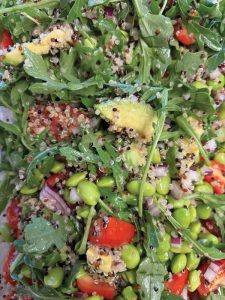Not all wheat is the same
 (Sept. 25, 2024) — To understand why the bread in Europe is easier to digest than bread here, let’s look at the flour used to make it.
(Sept. 25, 2024) — To understand why the bread in Europe is easier to digest than bread here, let’s look at the flour used to make it.
In the United States, the most common wheats (60% of the total grown) are varieties considered hard and red, according to an article in “The Cookbook for All.” Red wheats are reddish, which not only changes the color of the flour but adds a slightly bitter aftertaste due to the pigment.
Hard wheats are more robust and able to thrive in harsh winter conditions that would kill a soft wheat. Hard wheat has more protection in the form of a hard protein called gluten.
The United States uses hard wheat because it’s cheaper and the flour lasts longer, but it comes at the expense of our health because it’s higher in gluten. The gluten in hard wheat can make it more difficult to digest for some people. European countries use soft, white wheat, which has significantly lower protein/gluten levels, leading to reduced digestive discomfort for consumers.

People in ancient civilizations made bread by grinding wheat kernels with stones and producing a lumpy flour that retained more healthy fiber than today’s machines, which smooth out the flour. Ancient grains haven’t been refined like white flour.
Processed foods lack fiber and vitamins. Fiber protects the liver and feeds the gut. Many Europeans swear by the ancient grains that are still around centuries later, with the same genetic code. Examples of ancient grains include farro, sorghum, millet and amaranth.
Quinoa, which originated in South America, is also an ancient grain. Though quinoa is naturally gluten-free, it is often harvested with wheat, barley and rye; cross-contact with these grains may make it unsafe for those with extreme gluten sensitivities or celiac disease.
Gluten sensitivity, also called non-celiac gluten sensitivity, is not an autoimmune disease, and it does not cause intestinal damage as celiac disease does. Celiac disease is debilitating, so see your doctor if you’re unclear about your sensitivity.
Quinoa is rich in protein and antioxidants; a diet high in antioxidants has been linked with a decreased risk of heart disease. Try the delicious quinoa, edamame and avocado recipe included here.
My next article will look at how to identify and avoid the worst food additives.
Quinoa, Edamame and Avocado Salad
Makes 4-5 servings
2 c. cooked quinoa (frozen available)
2 c. cherry tomatoes, halved
2 avocados, peeled and cut into small cubes
2 c. arugula or baby spinach
1 c. edamame or chickpeas
¾ c. red onion, diced small
¼ c. extra-virgin olive oil
¼ c. lemon juice
1 T red wine vinegar
1 tsp. pressed or minced garlic
1 tsp. salt
Ground pepper to taste
Optional: 4-6 oz. salmon, shrimp or chicken or 2-3 oz. mozzarella, feta or nuts
Combine all ingredients. Store for up to three days.
Send questions and comments to cindymgershen@gmail.com.

Cindy Gershen
Cindy Gershen is an educator, nutritionist, chef, and co-author of “Fat Chance Cookbook.”
